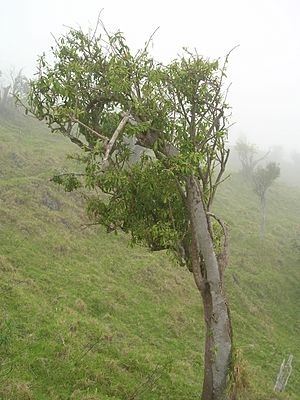Charpentiera facts for kids
Quick facts for kids Charpentiera |
|
|---|---|
 |
|
| Charpentiera obovata | |
| Scientific classification |
|
| Kingdom: | Plantae |
| Clade: | Tracheophytes |
| Clade: | Angiosperms |
| Clade: | Eudicots |
| Order: | Caryophyllales |
| Family: | Amaranthaceae |
| Subfamily: | Amaranthoideae |
| Genus: | Charpentiera Gaudich. |
| Species | |
|
Charpentiera australis |
|
Charpentiera is a group of flowering plants. These plants are part of the Amaranthaceae family. Most Charpentiera species, five of them, are found only in Hawaiʻi. In Hawaiʻi, they are called pāpala. There is also one species that grows only on Tubuai island in the Austral Islands.
All Charpentiera plants are trees. Some of these trees can grow quite tall, reaching over 10 meters (about 33 feet) in height. The name Charpentiera comes from Arsène Charpentier. He was a professor of pharmacy in the early 1800s.
What Are the Charpentiera Species?
There are several types of Charpentiera trees. Each type, or species, has its own scientific name. Most of them are found on different islands in Hawaiʻi.
- Charpentiera australis: This species is found only on Tubuai island.
- Charpentiera densiflora: You can find this tree on the island of Kauaʻi.
- Charpentiera elliptica: This species also grows on Kauaʻi.
- Charpentiera obovata: This type of pāpala grows on the main islands of Hawaiʻi.
- Charpentiera ovata: This species is found on several Hawaiian islands. These include Oʻahu, Molokaʻi, Maui, and the island of Hawaiʻi.
- Charpentiera tomentosa: This species has two main varieties:
- Charpentiera tomentosa var. maakuaensis: Found on Oʻahu.
- Charpentiera tomentosa var. tomentosa: Found on Oʻahu, Molokaʻi, Lānaʻi, Maui, and the island of Hawaiʻi.
How Pāpala Trees Were Used
Long ago, the Native Hawaiians living on the northwest coast of Kauaʻi used pāpala branches in a special way. They used them for an art called ʻōahi.
This art involved lighting lightweight pāpala branches on fire. Then, they would toss these burning branches off high sea cliffs. The wind currents, called ridge lifts, would keep the branches floating in the air. As they floated, they would burn brightly, looking like fireworks in the night sky. It was a beautiful and unique display.
See also
 In Spanish: Charpentiera para niños
In Spanish: Charpentiera para niños

